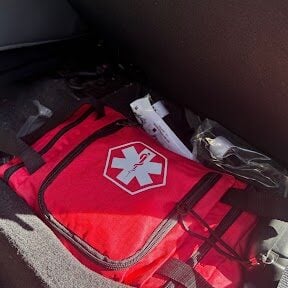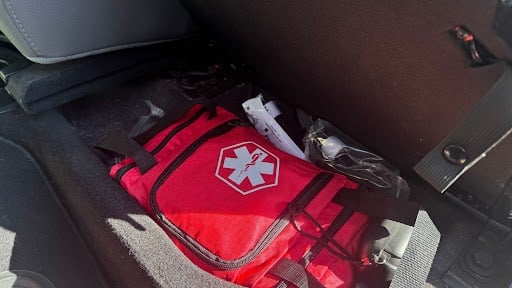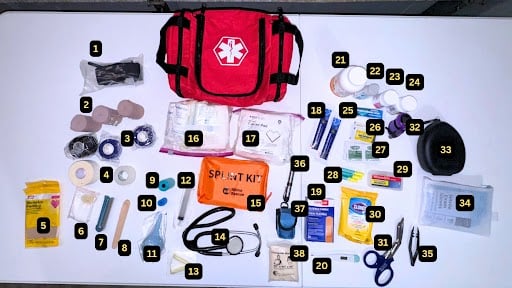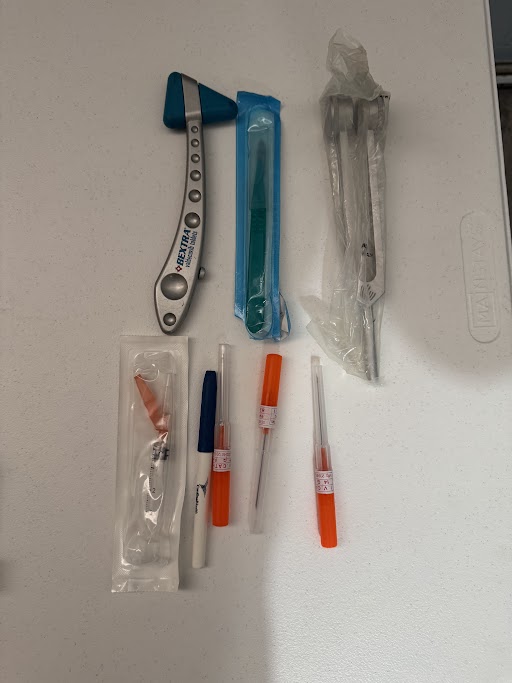
What’s in a Paramedic’s First Aid Kit?
After an elderly woman is injured in a fall, Ryan, our Zoom Instructor and licensed paramedic, jumps to the rescue!
Learn how he was able to help using only what he keeps in his truck.
Ryan’s Story
I was recently redoing my truck’s jump kit. I had to use it the other day at a community walk event.
Some kids were on the walking track and acting rambunctious. It caused an older lady to fall, hitting her head.
I ran over, she was a bloody mess.
Someone called for a first aid kit, but I knew that first aid kit would be small and store-bought; unlikely to be very useful.
I made the informed decision to bypass their kit, and instead, run an extra 30 yards to my truck where I knew I had a suitable kit.

What Did I Grab?
• Tons of Gloves – The standard kit didn’t have any.
• Bleeding Control
Various sizes of gauze, clot control powders, stipstik, nose gauze, tampons, etc.
• Penlight
To assess pupils (the patient had hit her head) and further assess her nose and face
• Tuning Fork
To help assess small fractures. She had a hurt wrist.
• Various Splints, Tape, Bandages, and Triangle Bandages
To make a splint, if necessary.
• Dog Poop Bags
We have lots of bloody gauze and trash. What do I do with it? Leave it there? No! I put the soiled stuff into dog poop bags.
• Wet Wipes, Sanitizing Wipes, Hand Sanitizer
There’s blood on the patient’s hands and arms. Am I going to let her go home like that? No!
• Neosporin with Cotton-Tipped Applicators
I’m not sure if she’ll have her own supplies at home, so I can at least get her started with an antibiotic to prevent infection.
• Notepad
To write down patient history and meds, should calling 911 be necessary. Having it written down creates an easy handoff and eliminates redundancy. I can also write down instructions, numbers, etc for the patient to remember when she gets home.
What’s In My First Aid Kit?
1. Commercial Tourniquet
2. Ace Bandages
3. Power Flex Bandage (Assorted Sizes)
4. Tape (Athletic & Medical)
5. Moleskin Padding
6. Finger Covers
7. Finger Splint
8. Tongue Depressors
9. Waste Bags
10. Constricting Band
11. Bulb Syringe
12. Syringe
13. Clamps
14. Stethoscope
15. Splint Kit (36”, 18”, 9”, finger)
16. Bleeding Control Baggie (gauze, gauze rolls, tampons)
17. Bleeding Control Baggie (large gauze pads)
18. Iodine Swabs
19. Band-Aids
20. Thermometer
21. Oral Glucose Tabs
22. Hand Sanitizer
23. Diphenhydramine
24. Non-Coated Aspirin
25. Hydrocortisone Cream
26. Antibiotic Ointment Packets
27. Alcohol Prep Pads
28. Bleeding Control Sticks
29. Bleeding Control Powder
30. Sanitizing Wipes
31. Trauma Sheers
32. Glucometer (with testing strips & lancets)
33. CPR Pocket Mask & Face Shield
34. Glove Pouch
35. Tweezers
36. Pen Light
37. Pulse Oximeter
38. Triangle Bandages

For Trained Personnel Only…
Because I’m trained to use them, I also carry these items – but they’re not suitable unless people are trained to use them.
1. Reflex Hammer
2. 15 Blade Scalpel
3. Tuning Fork
4. Syringes with Needles
5. Chest Needles






















